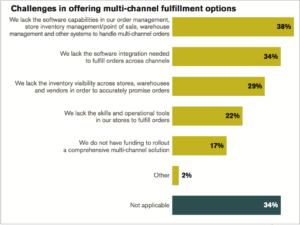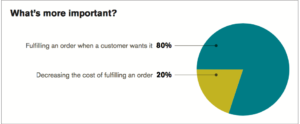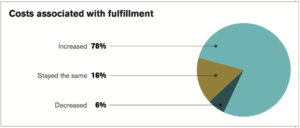If you think about the pace of shopping (both online and offline), the numbers could send you into a mild shock right off the screen (or paper), depending on how you are assimilating that information.
Consider online shopping: According to TrueShip, shoppers in the United states will spend a whopping $327 billion on online shopping alone. Consumers are expected to spend $31 billion straight off their mobile devices.
With that kind of shopping activity every retailer has a pressing need to get a few basics down: good UX/UI for ecommerce websites, fast loading times, a consistent and cross-channel enabled customer support, customer service, and even more importantly order fulfillment.
Just as natural as it is for customers to visit your ecommerce site (or retail store) to make purchases easily and quickly, customers also expect order fulfillment to be a natural extension of those transactions.
Retail business is not easy — it’s ultra-competitive, it’s unforgiving, and it demands precision and speed.
Without batting an eye, you’d need a certain degree of automation, faster order fulfillment, better inventory management, and a drastic reduction on order fulfillment errors (because they are prone to occur).
First, let’s see what the top dogs do, how they manage their retail order fulfillment processes, and a few insights into the retail sector in general.
According to a join study by Oracle and CapGemini, order fulfillment is now more intricate, challenging, and multi-faceted than ever. Meanwhile, the collective performance of companies surveyed reveal that areas of inventory management and delivery have a lot of room to improve.
Half of the respondents in the survey operate one or more warehouses of distribution centers. At least 31% of them manage 5 facilities on average. About 9 out of 10 retailers support more than one selling channels, with at least 4 channels being the average (these include catalogs, websites, storefronts, call centers, and telephone orders).
Specifically, for online orders which have customers picking up items at a store, merchandise is sent out from an internal warehouse (30%) or from the store itself (21%). About one-third of these retailers don’t offer in-store pickup. Most retailers (78%) still depend on “same stores metric” to evaluate a “store’s” success. This method, however, doesn’t take the “multi-channel” aspect of retailers which is more prevalent today.
Given below are a few of the challenges all retailers face today:

Interestingly, fulfilling orders is still a priority for retailers, regardless of costs.

Meanwhile, those costs are certainly increasing:

Here are a few tips for small businesses and ecommerce stores to help improve order fulfillment
Make Order Fulfillment a Priority
Companies like Zappos started not with a business plan but with a “Customer service plan”. From the start, it was more about a robust customer service mission than just another ecommerce business.
All that happened only because they “prioritized” customer support over everything else. Your small business needs all the love it can get and simple things like “shipping out products” in time cannot afford to get in the way. Seek ways to speed up the process of shipping and managing returns when you should.
Make that priority because that’s the only way you can set yourself on a committed path to better customer support.
Use an Outsourced Fulfillment Center
If you are an online store, a fulfillment center allows you to scale up your business when you are ready. In particular, consider outsourced fulfillment because it’d not make sense to spend capital on warehouses and distribution centers when you are just getting started.
Having a fulfillment center drastically improves your shipping and returns processes, allows you a faster turnaround when it comes to shipping out products, and gives you a solid system to manage your sales and inventory.
When choosing an outsourced fulfillment vendor, make sure they integrate with your existing ecommerce software and other tools you use primarily for your business.
Automate What You Can
If there are certain threads of your retail management that are repetitive and predictable, there’s a chance that those tasks can be automated. Starting from advanced inventory management and going all the way up to automated billing/invoicing/order processing, almost every predictable element of your process can be automated.
Free + Fast Shipping = Thrilled Customers
Free shipping is an effective marketing tool, and you should choose to offer it for your customers. To factor for the cost of free shipping, have them buy one or more items, allow free shipping over a specific dollar amount or choose a pre-determined time period or over a time frame (holiday season, for instance). Now, combine fast shipping with the “free option” and you now have a clear and distinct edge over your competition.
The combination of fast + free doesn’t have to be expensive or capital intensive. A few smarts and a good plan is all you need to make yourself competitive.
How fast and how accurately you ship out your items, whether or not you give your customers options to “pick up” and “pay” for their products, your returns process, and your refund policies will all impact your business success.
Doing it smart is obviously also an antidote to the ever-increasing costs of order fulfillment. In the midst of it all, having having an efficient system set in place will dramatically improve every facet of your business. An example would be NetSuite. It is designed to grow and scale your business efficiently.
How do you manage order fulfillment for your small business? What tools, processes, and policies do you have in place? What specific do you use for your business? Share your experiences with us.





